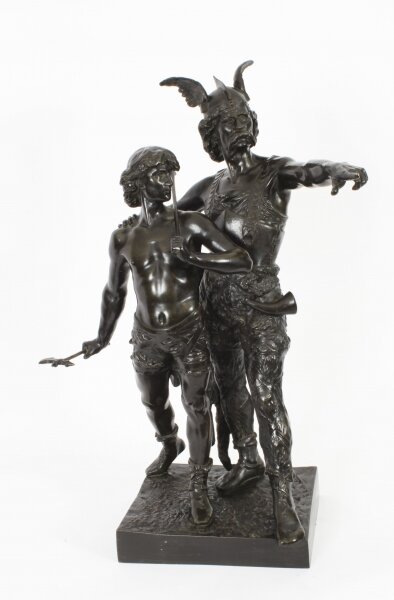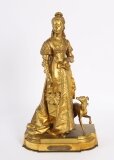This is a large French bronze sculpture of Vercingetorix with his son by Emile Laporte (1858 - 1901), circa 1890 in date.
The standing figure of Vercingetorix wearing a winged helmet, with arm raised pointing into the distance, a figure of a of his son at his side, holding an axe in his right hand, raised on a rectangular naturalistically cast base, signed and numbered M585 & Salon Des Beaux Arts, Paris on the base.
Emile Laporte was a French sculptor (1858 Paris to 1907) who attended the Academy in Paris and was a student of Gabriel-Jules Thomas, Augustin Dumont, Jean-Marie Bonnassieux and Louis-Ernest Barrias.
Hi exhibited his work at the Salon of French artists from 1881, his last work exhibited there dates from 1905.
The attention to detail is absolutely fantastic and the sculpture is extremely life-like.
Condition:
In really excellent condition, please see photos for confirmation.
Dimensions in cm:
Height 61 cm x Width 42 cm x Depth 35 cm
Weight 21.7 kg
Dimensions in inches:
Height 2 foot x Width 1 foot, 4 inches x Depth 1 foot, 2 inches
Weight 47.8 lbs
Our reference: A2905
Please feel free to email or call us (+44 20 8809 9605) to arrange a viewing in our North London warehouse.
In 53 BC, when Caesar had left for Italy after the summer campaign season, the Gallic tribes rebelled under the leadership of Vercingetorix, who raised an army against the Roman legions still wintering in Gaul. Hearing of the rebellion, Caesar crossed the mountains in the south, digging through snow drifts six feet deep, to rejoin his troops. "The very vigour and speed of his march in such wintry conditions," says Plutarch, "was a sufficient advertisement to the natives that an unconquered and unconquerable army was bearing down upon them" (Life of Julius Caesar, XXVI.3). To deprive the Romans of food and supplies, Vercingetorix had ordered a scorched-earth policy, and all the neighboring villages and farms were burned, "until fires were visible in all directions." But one tribe, already having torched twenty towns in a single day, refused to destroy its capital at Avaricum (Bourges), "almost the finest in Gaul, the chief defense and pride of their state."
Vergingetorix relented and set about to help defend the fortified town, which held a large supply of grain so desperately needed by the Romans. Caesar began a siege that lasted twenty-seven days. It now was early spring 52 BC, and, in spite of incessant rain, two wheeled towers, eighty-feet high, and ramps 330 feet long, over which they could be rolled into place, as well as a high siege terrace, were constructed in less than a month. The Gauls did all they could to counter or destroy the siege works. As the towers increased in height, so the defenders raised their own. They attacked the soldiers at work and tunneled under the terrace to undermine it. As the terrace approached the height of the wall, the defenders became desperate. Caesar writes that "They felt that the fate of Gaul depended entirely on what happened at that moment, and performed before our eyes an exploit so memorable that I felt I must not leave it unrecorded." It was almost midnight when they again had dug under the terrace and set it on fire. Opposite one of the towers, a Gaul was throwing pitch and tallow onto the fire when he was killed by an arrow from a catapult. Another man stepped forward to take his place and he, too, was killed. Another came forward and also was killed. This continued throughout the night until the fire finally was extinguished.
The next day, it began to rain heavily and, as the defenders took shelter, one of the siege towers was moved into position. The Gauls, taken by surprise, were dislodged from the walls and, panicked at the sight of the Romans surrounding them, threw down their weapons and fled. Exasperated at the length and difficulty of the siege, the Romans massacred the inhabitants. No-one was spared, "neither old men nor women nor children. Of the whole population—about forty thousand—a bare eight hundred who rushed out of the town at the first alarm got safely through to Vercingetorix."
Later that year, Vercingetorix and his men were trapped in the stronghold of Alesia, near present-day Dijon. Caesar surrounded the oppidum and began to construct siege works. The defenders had food only for a month, and Caesar hoped to starve them into surrender before reinforcements could arrive. The circumvallation extended around the town for ten miles, too large to be occupied by the Romans. It therefore was made more secure by a series of defenses. First, facing the town, a trench twenty-feet wide was dug to protect against surprise attack. Six hundred and fifty yards behind this ditch two more trenches were dug, each fifteen feet wide and the inner one filled with water. Behind these trenches was a palisaded rampart twelve feet high, with a breastwork of earth studded with forked branches. Around the entire circuit of the wall, towers were erected every 130 yards.
Still, there were attacks by the Gauls, and the siege works were strengthened even more. Tree trunks and strong branches were cut and sharpened, and buried securely in rows in front of the trenches. In front of them, diagonal rows of pits also were dug, each three-feet deep with a thick sharpened stake at the bottom and covered with brush to hide the trap. And, in front of these, blocks of wood were buried in the ground with iron barbs (stimuli) fixed in them. Aware that Vercingetorix had sent for reinforcements to break the siege, Caesar had an similar line of defense constructed facing outward to protect against attack from a relief force. By now, the food in the town had been exhausted, and it was determined that all those who could not fight were to be turned out. The inhabitants of Alesia, who had given refuge to Vercingetorix and his men, now were compelled to leave the town, together with their wives and children. Starving, they beseeched the Romans on the surrounding walls to take them in as slaves. But the population was refused any refuge and left to die of hunger between the two armies.
Caesar writes that 250,000 infantry and 8,000 cavalry assembled to relieve the besieged town. But the Gauls had difficulty communicating across the Roman siege works that ringed the oppidum and were not able to coordinate their efforts. Now surrounded, themselves, the Romans were able to repel the first assault. At midnight the next day, the Gauls suddenly attacked again, and Vercingetorix led his men out of the town in support. But it was too dark to see and, when the relief army came nearer the Roman defenses, "they suddenly found themselves pierced by the goads or tumbled into the pits and impaled themselves, while others were killed by heavy siege spears discharged from the rampart and towers." Before he could even reach the trenches, Vercingetorix heard the army retreating and was forced back behind the town walls. Again, the relief force reassembled: "The Gauls knew that unless they broke through the lines they were lost; the Romans, if they could hold their ground, looked forward to the end of all their hardships....on that day, he said, on that very hour, depended the fruits of all their previous battles." There was a desperate struggle. The Gauls filled the trenches with dirt and bundles of sticks, pulled down the breastworks with hooks, and drove the Romans from the towers. But Caesar, his presence marked by a scarlet cloak, attacked with cavalry and additional cohorts. The Gauls broke and fled, the relieving army giving up and returning to their homes.
Vercingetorix was forced to surrender and presented himself to Caesar. Confined and transported to Rome, he languished in the Tullianum for five years before being killed as part of his victor's triumph in 46 BC. Two years later, Caesar, himself, was dead.
Dimensions in cm:
Height 61 cm x Width 42 cm x Depth 35 cm
Weight 21.7 kg
Dimensions in inches:
Height 2 foot x Width 1 foot, 4 inches x Depth 1 foot, 2 inches
Weight 47.8 lbs
Shipping:
We ship worldwide and delivery within the London M25 is free of charge.
A shipping cost to all other destinations must be requested prior to purchase.
UK shipping times are typically 3-5 business days.
Buyers are fully responsible for any customs duties or local taxes that may be incurred on items sent outside of the United Kingdom, and we are not responsible for any delays in shipping or in the customs procedures of any jurisdiction, which are completely beyond our control.
To request a shipping quote for the items in your cart, please click HERE.
Delivery and return policy:
We require that someone be home on the agreed delivery day if applicable, otherwise a redelivery fee will apply.
In accordance with Distance Selling Regulations, we offer a 14-day money back guarantee if you are not satisfied with the item.
The item must be returned in its original packaging and condition.
Unless the item is not as described in a material way, the buyer is responsible for return shipping expenses.
Buyers are fully responsible for any customs duties or local taxes that may be incurred on items sent outside of the United Kingdom, and we are not responsible for any delays in shipping or in the customs procedures of any jurisdiction, which are completely beyond our control.
Please be advised that claims for damage with certain carriers can sometimes take several months to resolve, and we would be grateful for your patience and cooperation throughout the process.
Returns will be processed and refunds issued within 2-3 business days of receipt.




















